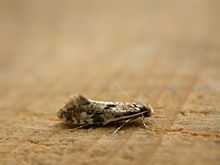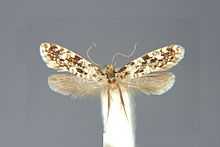Nemapogon cloacella
- "Cork Moth" redirects here. Not to be confused with the Wine Moth, Oinophila v-flava.
- "Tinea infimella" redirects here. The species invalidly described under that name by Corbet in 1943 is Nemapogon variatella.
| Cork Moth | |
|---|---|
 | |
 | |
| Scientific classification | |
| Kingdom: | Animalia |
| Phylum: | Arthropoda |
| Class: | Insecta |
| Order: | Lepidoptera |
| Family: | Tineidae |
| Genus: | Nemapogon |
| Species: | N. cloacella |
| Binomial name | |
| Nemapogon cloacella (Haworth, 1828) | |
| Synonyms | |
|
[1] | |
The Cork Moth (Nemapogon cloacella) is a species of tineoid moth. It belongs to the fungus moth family (Tineidae), and therein to the subfamily Nemapogoninae. Its junior synonym N. infimella was established by G.H. Heydenreich in the 1851 volume of his Lepidopterorum Europaeorum Catalogus Methodicus, but many sources still attribute it to G.A.W. Herrich-Schäffer, who supposedly narrowly beat Heidenreich in (re)describing the species. But as it seems, Herrich-Schäffer was merely one of the first to use the name proposed by Heydenreich, as the volume of his Systematische Bearbeitung der Schmetterlinge von Europa where he discussed the Cork Moth was not published until 1853 or 1854. That all nonwithstanding, the species had been already validly described by A.H. Haworth in the 1828 volume of Lepidoptera Britannica.[2]
Ecology and description
N. cloacella is a widespread species, found all across western Eurasia. It is reportedly absent from France, but given that it occurs in all surrounding countries, this is unlikely to be correct. Its preferred habitat is woodland with a large amount of dead trees. The crepuscular adults are on the wing throughout the summer and are typically encountered at dusk but sometimes can be seen earlier in the day.[3]
This small moth has a wingspan of 10–18 mm. The forewings are irregularly mottled black, white and grey, resembling congeners such as the European Corn Moth (N. granella). The head has a tuft of pale yellow hairs. The caterpillars feed mainly on bracket fungi. Their food spectrum has been subject to considerable dispute in the past due to confusion with the European Corn Moth. Some claimed that N. cloacella caterpillars eat a wide range of food – dried fruit and mushrooms, seeds and other vegetable material, e.g. cereal grains, Capsicum annuum fruit, poppyseed (Papaver somniferum), bitter almonds (Prunus amygdalus amara) or bilberries (Vaccinium), but even cork (hence its common name) and beeswax. Other authors stated that they were only found on the Oak Mazegill fungus (Daedalea quercina), and ascribed the wide range of foodstuffs to N. granella. But as it seems, neither extreme was correct; the caterpillars do eat preferentially fungi – not only the Oak Mazegill but also others (e.g. Birch Polypore, Piptoporus betulinus) –, feeding on plant debris and similar materials when their favorite food is not available.[4]
Footnotes
References
- Fauna Europaea (FE) (2009): Nemapogon cloacella. Version 2.1, 2009-DEC-22. Retrieved 2010-MAY-06.
- Grabe, Albert (1942): Eigenartige Geschmacksrichtungen bei Kleinschmetterlingsraupen ["Strange tastes among micromoth caterpillars"]. Zeitschrift des Wiener Entomologen-Vereins 27: 105-109 [in German]. PDF fulltext
- Kimber, Ian [2010]: UKmoths – Nemapogon cloacella. Retrieved 2010-MAY-05.
- Robinson, Gaden S. [2010]: Global Taxonomic Database of Tineidae (Lepidoptera) – Nemapogon cloacella. Retrieved 2010-MAY-06.
- Savela, Markku (2003): Markku Savela's Lepidoptera and some other life forms – Nemapogon cloacellus [sic]. Version of 2003-DEC-27. Retrieved 2010-MAY-06.